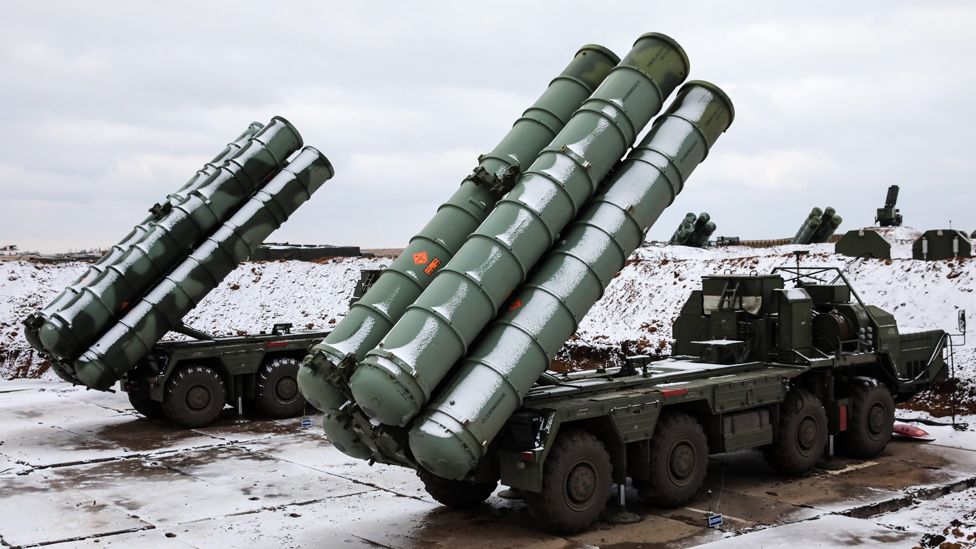Why is the US displeased with India's S-400 purchase?

Sunday, October 10, 2021 | Chimniii Desk
Highlights
- India is expected to receive the first batch of sophisticated Russian S-400 missile defence systems by the end of this year — a highly regarded air defence technology.
- It is capable of tracking and neutralising threats, thereby enhancing the armed forces' air defence capabilities.
- To bolster its defences, India struck a $5 billion contract with Russia in October 2018 to acquire five S-400 air defence missile systems.
- Despite concerns that the acquisition might trigger Countering America's Adversaries Through Penalties Act (CAATSA) sanctions, India made the first tranche of payment to Russia in 2019, totalling around $800 million.
- India had been warned by the Trump administration that if it proceeded with the contract, it would face US sanctions.
Advertisement
India is expected to receive the first batch of sophisticated Russian S-400 missile defence systems by the end of this year — a highly regarded air defence technology. It is capable of tracking and neutralising threats, thereby enhancing the armed forces' air defence capabilities.
On October 5, 2021, Air Chief Marshal Vivek Ram Chaudhari, the head of the Indian Air Force, stated that the delivery is expected to occur on schedule. His remarks came during the customary news conference preceding October 8's Indian Air Force Day.
What is the S-400 anti-missile system?

Pic: S400 missile defence system
The S-400 Triumph (NATO reporting name) is a sophisticated air defence missile system comprised of radars, control systems, and various missile types. It was developed in the 1990s as an upgrade to Russia's S-300 series of surface-to-air missile systems by the Almaz Central Design Bureau. Since 2007, it has been in service with the Russian Armed Forces.
The S-400 air defence system includes targeting systems, multifunction radar, autonomous detection, anti-aircraft missile systems, launchers, and a command and control centre.
It is capable of engaging aerial targets, such as aircraft, unmanned aerial vehicles (UAVs), ballistic and cruise missiles, within a range of 400 kilometres at a maximum altitude of 30 kilometres, and can fire three different types of missiles to create a layered defence.
The system is said to be capable of engaging 36 targets simultaneously, and when compared to the S-300, the upgraded and advanced version features four new missile types ranging from short-range (40 kilometres) to very long-range (400km).
The command post, which is equipped with LCD consoles for processing airspace surveillance data, is responsible for controlling and monitoring long-range surveillance radar. It monitors and prioritises airborne threats.
According to reports, the radar is capable of detecting and tracking aircraft, rotorcraft, cruise missiles, guided missiles, drones, and ballistic rockets up to a range of 600 kilometres.
The system was purpose-built to identify and destroy modern fighter planes such as the F-16 and F-22, as well as missiles such as the Tomahawk.
Advertisement
Why is the US displeased with New Delhi's acquisition of the Russian military system?

To bolster its defences, India struck a $5 billion contract with Russia in October 2018 to acquire five S-400 air defence missile systems. Despite concerns that the acquisition might trigger Countering America's Adversaries Through Penalties Act (CAATSA) sanctions, India made the first tranche of payment to Russia in 2019, totaling around $800 million. India had been warned by the Trump administration that if it proceeded with the contract, it would face US sanctions.
CAATSA, or Countering America's Adversaries Through Sanctions Act, is a tough US law that empowers the administration to impose sanctions on countries that purchase significant defence hardware from Russia in response to Russia's 2014 annexation of Crimea and alleged meddling in the 2016 US presidential election.
However, on October 5, 2021, India stated that it is in talks with the US on the S-400 missile defence agreement, a day after US Deputy Secretary of State Wendy Sherman voiced concern about the proposed acquisition of the Russian military system.
"This has been on the table for some time between our two countries. It was brought up, and we discussed it and stated our position. Additionally, negotiations on this subject are underway "Arindam Bagchi, the External Affairs Ministry's spokesman, stated.
Sherman stated during a three-day visit to India that President Joe Biden and Secretary of State Antony Blinken will make any decision about prospective penalties on the S-400 agreement.
Washington has already stated that the S-400s endanger its F-35 fighter planes and NATO's larger defence systems. As was the case when Turkey got the first S-400 surface-to-air missile systems from Russia in July 2019, the US began withdrawing Turkey from the F-35 stealth fighter programme due to security concerns.
India, on the other hand, is certain of obtaining a waiver, owing to the critical strategic relationship with the United States.
Advertisement